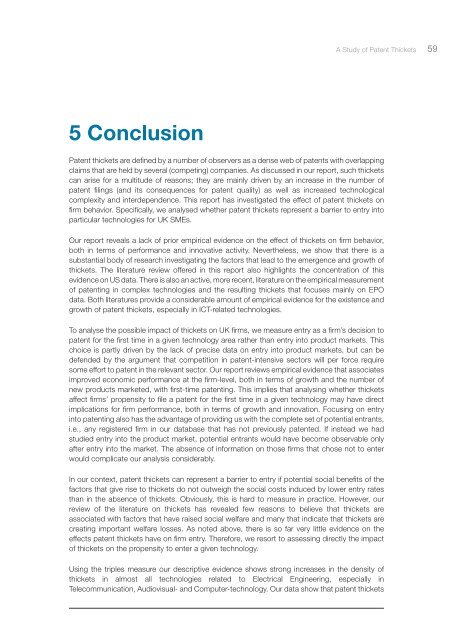A study of Patent Thickets (1.31Mb) - UK Intellectual Property Office
A study of Patent Thickets (1.31Mb) - UK Intellectual Property Office
A study of Patent Thickets (1.31Mb) - UK Intellectual Property Office
You also want an ePaper? Increase the reach of your titles
YUMPU automatically turns print PDFs into web optimized ePapers that Google loves.
A Study <strong>of</strong> <strong>Patent</strong> <strong>Thickets</strong> 59<br />
5 Conclusion<br />
<strong>Patent</strong> thickets are defined by a number <strong>of</strong> observers as a dense web <strong>of</strong> patents with overlapping<br />
claims that are held by several (competing) companies. As discussed in our report, such thickets<br />
can arise for a multitude <strong>of</strong> reasons; they are mainly driven by an increase in the number <strong>of</strong><br />
patent filings (and its consequences for patent quality) as well as increased technological<br />
complexity and interdependence. This report has investigated the effect <strong>of</strong> patent thickets on<br />
firm behavior. Specifically, we analysed whether patent thickets represent a barrier to entry into<br />
particular technologies for <strong>UK</strong> SMEs.<br />
Our report reveals a lack <strong>of</strong> prior empirical evidence on the effect <strong>of</strong> thickets on firm behavior,<br />
both in terms <strong>of</strong> performance and innovative activity. Nevertheless, we show that there is a<br />
substantial body <strong>of</strong> research investigating the factors that lead to the emergence and growth <strong>of</strong><br />
thickets. The literature review <strong>of</strong>fered in this report also highlights the concentration <strong>of</strong> this<br />
evidence on US data. There is also an active, more recent, literature on the empirical measurement<br />
<strong>of</strong> patenting in complex technologies and the resulting thickets that focuses mainly on EPO<br />
data. Both literatures provide a considerable amount <strong>of</strong> empirical evidence for the existence and<br />
growth <strong>of</strong> patent thickets, especially in ICT-related technologies.<br />
To analyse the possible impact <strong>of</strong> thickets on <strong>UK</strong> firms, we measure entry as a firm’s decision to<br />
patent for the first time in a given technology area rather than entry into product markets. This<br />
choice is partly driven by the lack <strong>of</strong> precise data on entry into product markets, but can be<br />
defended by the argument that competition in patent-intensive sectors will per force require<br />
some effort to patent in the relevant sector. Our report reviews empirical evidence that associates<br />
improved economic performance at the firm-level, both in terms <strong>of</strong> growth and the number <strong>of</strong><br />
new products marketed, with first-time patenting. This implies that analysing whether thickets<br />
affect firms’ propensity to file a patent for the first time in a given technology may have direct<br />
implications for firm performance, both in terms <strong>of</strong> growth and innovation. Focusing on entry<br />
into patenting also has the advantage <strong>of</strong> providing us with the complete set <strong>of</strong> potential entrants,<br />
i.e., any registered firm in our database that has not previously patented. If instead we had<br />
studied entry into the product market, potential entrants would have become observable only<br />
after entry into the market. The absence <strong>of</strong> information on those firms that chose not to enter<br />
would complicate our analysis considerably.<br />
In our context, patent thickets can represent a barrier to entry if potential social benefits <strong>of</strong> the<br />
factors that give rise to thickets do not outweigh the social costs induced by lower entry rates<br />
than in the absence <strong>of</strong> thickets. Obviously, this is hard to measure in practice. However, our<br />
review <strong>of</strong> the literature on thickets has revealed few reasons to believe that thickets are<br />
associated with factors that have raised social welfare and many that indicate that thickets are<br />
creating important welfare losses. As noted above, there is so far very little evidence on the<br />
effects patent thickets have on firm entry. Therefore, we resort to assessing directly the impact<br />
<strong>of</strong> thickets on the propensity to enter a given technology.<br />
Using the triples measure our descriptive evidence shows strong increases in the density <strong>of</strong><br />
thickets in almost all technologies related to Electrical Engineering, especially in<br />
Telecommunication, Audiovisual- and Computer-technology. Our data show that patent thickets

















